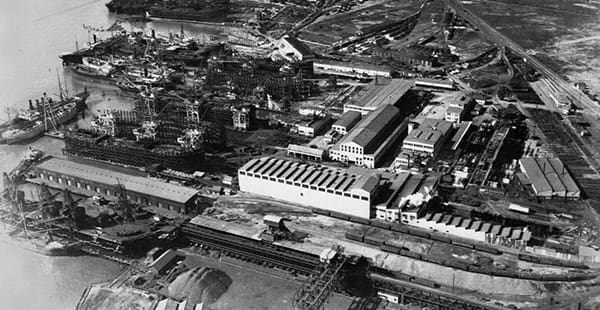01. History
Moore Dry Dock Company History
Moore & Scott Iron Works was founded in San Francisco, California, in 1905. It bought the Boole & Sons shipyard in 1909, relocating to Oakland, California. It was renamed Moore Shipbuilding in 1917. During World War I, the shipbuilding business grew with wartime contracts. During this time, the company employed 12,000 workers.
When business slowed after World War I ended, it shifted its operations to ship repair and steel production. In 1922, the shipyard finally became Moore Dry Dock Company. Between the two World Wars, Moore Dry Dock Company built bridges in the Bay Area. The company constructed caissons for the San Francisco-Oakland Bay Bridge in 1933. It also erected the Park Street and High Street Bridges, produced structural steel for buildings and repaired ships.
After World War II began, the U.S. Navy and Maritime Commission invested $18 million in the shipyard. Wartime work focused mainly on ship repair, but workers at the yard also built dozens of cargo and assault ships. In 1943, a record 37,000 workers were employed at the shipyard. After the war ended, contracts slowed again. The shipyard closed in 1961, eventually selling to Schnitzer Steel. It built over 200 ships during its tenure.
Moore Dry Dock Company History at a Glance
- Other Names: Moore & Scott Iron Works, Moore Shipbuilding
- Location: Oakland, California
- Owner(s): John Thomas Scott, Joseph A. Moore, Robert S. Moore, Schnitzer Steel
- Years of Operation: 1905 – 1961
- Wartime Operations: World War I (WWI), World War II (WWII)
- Size of Shipyard: 128 acres
- Noteworthy Ships: Elizabeth C. Stanton, Tangier II
- Types of Ships Built/Serviced: Assault ships, cargo ships, dredges, ferries, salvage ships, tankers
For many years, asbestos was used to insulate hulls, pipes and boilers on ships. Shipyards also used asbestos for heat insulation and fireproofing. Many shipyard workers exposed to asbestos have since developed asbestos diseases.
Notable Ships Built and Repaired
Moore Dry Dock Company built and repaired many ships during both World Wars. Some of these ships were instrumental in the war efforts. Here are the stories of two.
Elizabeth C. Stanton (AP-69)
Moore Dry Dock Company launched the cargo ship Elizabeth C. Stanton in 1939. The ship was commissioned for the Navy in 1942. It fought in North Africa twice before fighting in the invasion of Sicily in 1943. In advance of the invasion of Normandy, the ship transported troops and cargo to the British Isles in 1944. It also fought in southern France and throughout the Mediterranean.
The Elizabeth C. Stanton went on to transport troops across the Pacific, including for the occupation of Japan. After World War II, the ship was decommissioned, earning five battle stars.
Asbestos was commonly used in ships during World War II. Any exposure that occurred as the Elizabeth C. Stanton transported troops and cargo may have led to the development of diseases like mesothelioma.
Tangier II (AV-8)
Moore Dry Dock Company launched the cargo ship Tangier II in 1939. But it was converted to a seaplane tender before going to war. In 1941, it traveled to Pearl Harbor and was still there when Japanese forces attacked the base. During the fight, it defeated three enemy planes and helped defeat a submarine. After the battle, it rescued survivors from the capsized battleship Utah.
For the rest of the war, it traveled across the Pacific, fighting and rescuing survivors and civilians. Moore Dry Dock Company overhauled the ship in 1945 before it continued serving. The Tangier II was decommissioned in 1947, having earned three battle stars.
As with the Elizabeth C. Stanton, the Tangier II likely contained asbestos. The ship could have potentially exposed many people to asbestos, including those who served aboard and those it rescued.
Resources for Mesothelioma Patients
02. Asbestos Use
Asbestos Use at Moore Dry Dock Company
Asbestos was used widely on ships and in shipyards like Moore Dry Dock Company alike. The mineral is naturally strong and resistant to heat and fire, which made it popular in construction. On ships, it was used to insulate pipes, engine and boiler rooms and more. It appeared in machinery parts, bulkhead panels, decking and floor tiles and cement. Shipyards themselves used asbestos in fireproofing and insulation as well.
Asbestos Exposure at Moore Dry Dock Company
With how widely asbestos was used, many kinds of workers were at risk of asbestos exposure at Moore Dry Dock Company. Workers who had to install, repair or remove asbestos insulation were at greater risk. But even those who worked around it, like Navy veterans, were at risk, too.
Occupations that had a risk of asbestos exposure at Moore Dry Dock Company include:
- Boiler workers
- Electricians
- Foundry workers
- Insulators
- Joiners
- Machinists
- Masons
- Mechanics
- Molders
- Painters
- Pipefitters
- Sheet metal fabricators
- Shipfitters
- Shipwrights
- Steamfitters
- Toolmakers
- Track workers
- Veterans
- Welders
- Wharf builders
- Woodworkers
Many shipyard workers exposed to asbestos have since developed related diseases like mesothelioma.
03. Lawsuits
Asbestos Lawsuits for Moore Dry Dock Company
One option for asbestos victims to seek compensation is filing lawsuits against responsible companies. A mesothelioma lawsuit can compensate asbestos victims for medical bills, lost wages and more. Successful lawsuits may end in a verdict or settlements.
To explore your legal options, speak with a mesothelioma lawyer. They can help you pursue the best compensation route for your case. Other than executing a lawsuit, they can also help with Veterans Affairs claims and asbestos trust fund claims.
04. Trust Fund Claims
Asbestos Trusts Associated With Moore Dry Dock Company
Some asbestos companies have declared bankruptcy from facing asbestos litigation. As a part of that process, they may establish asbestos trust funds to compensate future victims.
Asbestos Trust Funds and Eligible Years of Employment
The following companies provided asbestos products to Moore Dry Dock Company. They exposed innocent people to asbestos and have faced many asbestos lawsuits. After filing for bankruptcy, they created asbestos trust funds to pay victims. Those who worked at Moore Dry Dock Company and developed asbestos diseases may be able to file claims against these companies’ trusts.
| Asbestos Company Name | Eligibility Start Date | Eligibility End Date |
|---|---|---|
| Combustion Engineering | 12/31/1982 | |
| Fibreboard | 1/1/1940 | 12/31/1982 |
| Keene | 1/1/1941 | 12/31/1971 |
| Owens Corning | 1/1/1944 | 12/31/1982 |
| Plant Insulation | 1/1/1935 | 1/1/1986 |
| Western MacArthur | 1/1/1999 |









